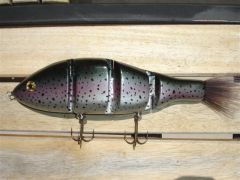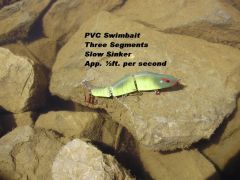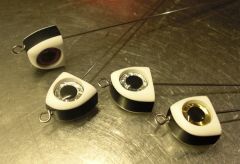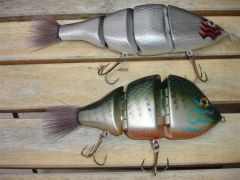-
Posts
14,726 -
Joined
-
Last visited
-
Days Won
364
Content Type
Profiles
Articles
TU Classifieds
Glossary
Website Links
Forums
Gallery
Store
Everything posted by mark poulson
-
-
76gator, Don't you just love it when you work your butt off to get a really good paint job, and then do something dumb to ruin it! My favorite is dropping it onto the dirty carpet runners in my garage while the paint's still wet.
-
76gator, You're right. It is expensive, so I only use it on small balsa baits. And I don't do production, just repaints as they are needed, so I don't use that much glue. I use Zap runny crazy glue that I get from the hobby store, and it last a long time. One drop covers a lot. But make sure you use it with good ventilation. I'm not sure what they are, but the fumes from crazy glue are really hard on your sinuses. That awfull smell is trying to tell us something.
-
John, You can cut that 15 hours down to 3 by making solid lures with no thru wiring. One of the beauties of PVC, aside from it's being waterproof and buoyant, is that it's strong enough to hold screw eyes. Just make a small pilot hole, and brush the screw eye's threads with crazy glue before you run it/them in. I know thru wire is important with balsa lures, and I know JR Hopkins does it with his PVC lures, since he uses 1/2" material and laminates it, but the AZEK decking I use is 15/16" thick, so, even after I remove the polished surface, it's still 13/16" thick, which is plenty for my swimbaits. Any thicker, and they would weigh a ton. Try .072 sst screw eyes for the line ties and hook hangers, and .092 for the hinges. On larger baits, I use a sst cotter pin pushed through an 1/8oz egg sinker, and then bent over and clipped short, for my hook hangers, so there is already some ballast in the sections, first and third, that need it. On smaller baits, I only use the weighted hook hanger in the front, and use the .072 for both the rear hook hanger and the last hinge, too, to keep the weight down. Either size will accomodate the sst bicycle spokes that I use for the hinge pins (thanks Captnsully). I think it's important to remember that the hinge joints are really most stressed by the actual swimming of the lure, as opposed to the actions of the fish once it's hooked. Unless the fish jumps, the force from a hooked fish us usually just a steady pull. Even if they shake their heads underwater, it doesn't generate that much strain on the hinges, even if they only have the rear hook in their mouths. If a fish jumps, it tries to use the weight of the lure to shake it free from their mouths, and, unless you drop your rod and keep tension on the, they'll succeed. But they aren't going to pull an 1 1/4" screw eye out of the lure. If you doubt it, do an experiment. Tie a 20' length of 20lb test mono to an screw eye embedded in a piece of PVC, wrap the other end of the line around a piece of wood for a handle and tie it off, clamp the test piece with the screw eye in a vise, and pull. You'll break the line long before the screw eye moves, and, since most of our hinges have two screw eyes each, the force is shared. The rod and line are a build in shock absorber. Even with braid, you still have the rod. It will break before the screw eye pulls out. Anyone who had hung up a lure on an underwater snag will tell you the same thing. They are a bear to pull loose, and, if you do manage it without a lure retriever, either you get it back with a piece of the tree that you snagged, or with a straightened out hook. I have three retrievers on my boat, because I work too hard to lose my lures. The one with the extendable handle has saved so many lures I christened it the Golden Retriever. Sorry to rant. I just hate to see you put that much time into each lure, when you could be fishing!
-
I found the Minwax Wood Hardener penetrates plenty if you let a bait soak for 5 minutes. After that, it's just not doing much more, except pulling hardener deeper into the wood, where it will take longer to dry. It's not a primer, so don't expect it to give the wood a sheen. You should use a primer to make sure your finish paint has a good bond to the bait. I also found that it takes at least 24 hours for the wood hardener to release it's solvent. After 24 hours, I lightly sand it and put on my primer. Before you put on the primer, hit the lure with a hair dryer to see if there is any solvent left. If there is, it will bubble off, and you should let it sit another 24 hours to competely off gas. You'll see the bubbles at the end grain. Otherwise, you'll get bubbles in your paint when you go to heat set it. I don't use wood hardener on small balsa baits. I use the runny crazy glue, two coats, and that works really well. It dries really hard and seals the balsa for sanding. Plus it dries fast, so I can sand and prime an hour after the second coat.
-
I typically like short shank, to minimize fouling, but I use regular shank 3/0s, because that's all I have on hand.
-
-
Use a fine file to make a small flat where the eyes go. More control than with a drill. And if you do file down into the cavity, it will just be in the center, which will be covered by the eye, and so it will be sealed when you top coat the lure. Just put a drop of crazy glue onto the eyes before you top coat. If you use small eyes, you can just stick them on, put on a drop of crazy glue to make sure they stay put, and epoxy over the whole shebang. Even if the edges of the eyes protrude a little, they won't come off, and they add a little extra turbulence to the bait. The fish won't care.
-
I use 1/0 for 7" and 8", and 3/0 for 10" and up. Almost all jointed lures that swim really well will have the hooks foul once in a while, so I don't worry about trying to keep them clear of each other like I do when I'm rehooking a crank bait. But I think the bigger hooks on the bigger bait are needed to make sure that when a big fish clamps down on the bait, the hooks are big enough to make good contact with the inside of the mouth to ensure a good hookset. If you look at the actual hooksize on a treble, a 1/0 treble is really three 1/0 hooks welded together. The actual bite, the space between the hook shank and the point, isn't really that big. Think of the size hooks you use for flukes and other plastics. Since the shank of a treble is attached to the middle of the lure's body, I think the point is too close to the lure body on a big bait if I don't use at least a 3/0 treble.
-

Problems with getting a 3 jointed plastic bait to sink evenly...
mark poulson replied to Weight Issues's topic in Hard Baits
Vodkaman's right, it's a ballast issue. Sounds to me like your choice of lure material may be part of the problem. when I switched to PVC. I had been using poplar, a strong but light hardwood, but when I switched to PVC, I faced the same dilemma. Because PVC is a little less buoyant than wood, I found that my usual method of including a 1/8oz egg sinker in my rear hook hanger resulted in the tail drooping, even on my floaters. The drooping tail, to me, gave the appearance of a trout either struggling to stay up at the surface, in the case of the floaters, or struggling to reach the surface. It's an interesting, effective retrieve, but it doesn't really work well on either a dead stick floater, or on a steady retrieve sinker, where the trout is supposed to appear unfazed and clueless, just swimming along without a care in the world. So I tried putting ballast only in the head. The lures float and sink level, but there was an unforeseen consequence. One of the features that makes jointed swimbaits really attractive is their ability to turn and face to the rear on a jerk/pause retrieve. This change of direction is sometimes the triggering mechanism to turn followers into biters. But that action requires enough ballast in the rear portion of the lure to produce enough inertia to keep the rear moving when the front stops, which results in the turning action. It's the reason top water walking baits and gliders are slightly rear weighted. So, when I put all the ballast in the head, the lures swim perfectly level, whether floaters or sinkers, because the tail sections are weightless, but they don't have enough ballast to initiate the turn on the jerk/pause retrieve. I like the PVC so much I won't go back to wood. So I thought it through, since many swimbait guys swear by one type of action or the other, and decided to make both types, to cover all the bases! -
I think a heat gun is too strong for lure painting, unless you're really experienced with it. Otherwise, it's like killing flies with an elephant gun. After all, heat guns are used to remove paint, by bubbling them off the surface. A hair dryer is much more user friendly. In my case, read that idiot proof!
-
Before you stress too much about the edge finish, try putting one of the bills underwater after you've sanded the edge. It should turn transparent, because the water fills in the scratches. Just be sure you sand down to at least 100 grit.
-
I haven't used DN yet, but I would look at the thinner, which might have weakened the finish, or altered it's properties and film strength, making it more chip-prone. If you can, try dipping a lure and see if the finish holds up better.
-
John, Again, congratulations on your success. They swim great. One of the things I love about PVC is that it holds screw eyes great. I found that using a screw eye and bike spoke hinge system is much faster than through wire, and is completely solid with PVC. You might think of making one just to test it out. If you're laminating two pieces together to make the lure blank, the glue line will be the perfect center line to help with symetry and hardware location. If you use one thicker piece, be sure to mark you center line after you've cut out the profile, before you shape the sides, so you have a guide line.
-
For plastic baits, I wipe the plastic down with acetone, and then paint right over it with Createx. On a repaint, if I'm doing a "clear" type finish, like a ghost pattern, I scrape the old paint off, and then finish the removal with the acetone. If I'm doing a solid paint scheme, I lightly sand the old finish for adhesion, wipe it with acetone, and paint on my base coat. For wood baits I seal with Minwax Wood Hardener, then prime with Krylon white primer. I think the wood hardener helps make the lure more waterproof. Water that gets under the top coat is the biggest problem with wood baits for me. If it can actually penetrate the wood, it vaporizes under the top coat, and makes the paint scheme delaminate and fail. Primer is supposed to lock the wood fibers, so you can sand lightly to achieve a smoother surface to paint, and to promote adhesion of the finish paint to the lure. Generally, the actual paint formulation is geared toward penetrating the wood, to promote adhesion, and the film strength is low, so it can be easily sanded, and so it provides a good mechanical bonding surface with the finish paints which go over it. The Minwax wood hardener might serve the same purpose as the primer by itself, in terms of locking the wood fibers and providing a good sanding surface, but I've never tried it alone. For PVC baits, which is what I use almost exclusively now, I just sand, prime with Krylon white primer, and then paint with Createx. A solid white basecoat is a good starting point for almost all paint schemes, and a white primer helps achieve better coverage with my Createx white base coat. I do a black crappie pattern with a black basecoat, and that's the only time I don't use white. But I still prime with Krylon white primer. I think any rattle can white primer would probably work, but I've never had a problem with the Krylon.
-
-
-
Next time I'll check Walmart's first.
-
-
Talk about great service, I ordered the lead wire yesterday, and it arrived, UPS, today! McMaster Carr rocks!
-
-
Thanks to everyone for their help. You guys are the best. I bought a 5lb, 20' roll from McMaster Carr. That should last me for a while. At 8 grams to the inch, that's a lot of ballast.
-
Dave, Either youtube is banned in your country, or a travel tank full of big bass feeding on trout is considered online porno there, just like here. Maybe I can email it to you as an attachment. I'll give it try later today.
-
In my experience repainting cranks, one coat of Etex is fine for plastic lures, because they are so hard. For wood lures, I'd do at least two coats.









